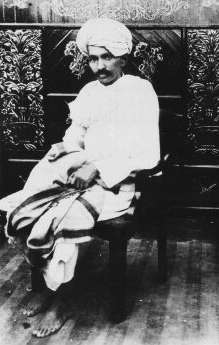Kheda Satyagraha of 1918
The Kheda Satyagraha of 1918, in the Kheda district of Gujarat, India during the period of the British Raj, was a Satyagraha movement organised by Mohandas Karamchand Gandhi. It was a major revolt in the Indian independence movement. It was the second Satyagraha movement after Champaran Satyagraha.[1] Gandhi organised this movement to support peasants[2]
 Gandhi in 1918, when he led the Kheda Satyagraha. | |
| English name | Kheda Satyagraha |
|---|---|
| Date | 18 February - 5 June, 1918 |
| Location | Kheda district of Gujarat, India during the period of the British Raj |
| Patron(s) | tap |
| Organised by | Gandhi,Sardar Vallabhbhai Patel Indulal Yagnik, Shankarlal Banker, Mahadev Desai, Narhari Parikh, Mohanlal Pandya and Ravi Shankar Vyas |
Leaders
In Gujarat, Mahatma Gandhi was chiefly the spiritual head of the struggle. His chief lieutenant, Sardar Vallabhbhai Patel and a close coterie of devoted Gandhians, namely Indulal Yagnik, Shankarlal Banker, Mahadev Desai, Narhari Parikh, Mohanlal Pandya and Ravi Shankar Vyas toured the countryside, organised the villagers and gave them political leadership and direction.[3] Many aroused Gujaratis from the cities of Ahmedabad and Vadodara joined the organizers of the revolt, but Gandhi and Patel resisted the involvement of Indians from other provinces, seeking to keep it a purely Gujarati struggle.
The Struggle
Patel and his colleagues organised a major tax revolt, and all the different ethnic and caste communities of (Kheda) rallied around it. The peasants of Kheda signed a petition calling for the tax for this year to be scrapped in wake of the famine. The government in Bombay rejected the charter. They warned that if the peasants did not pay, the lands and property would be confiscated and many arrested. And once confiscat
The tax withheld, the government's collectors and inspectors sent in thugs to seize property and cattle, while the police confiscated the lands and all agrarian property. The farmers did not resist arrest, nor retaliate to the force employed with violence. Instead, they used their cash and valuables to donate to the Gujarat Sabha which was officially organising the protest.
The revolt was astounding in terms of discipline and unity. Even when all their personal property, land and livelihood were seized, a vast majority of Kheda's farmers remained firmly united in the support of Patel. Gujaratis sympathetic to the revolt in other parts resisted the government machinery, and helped to shelter the relatives and property of the protesting peasants. Those Indians who sought to buy the confiscated lands were excluded from society. Although nationalists like Sardul Singh Caveeshar called for sympathetic revolts in other parts, Gandhi and Patel firmly rejected the idea.
Result
The Government finally sought to foster an honourable agreement for both parties. The tax for the year in question, and the next would be suspended, and the increase in rate reduced, while all confiscated property would be returned.
People also worked in cohesion to return the confiscated lands to their rightful owners. The ones who had bought the lands seized were influenced to return them, even though the British had officially said it would stand by the buyers.[4]
See also
- Champaran Satyagraha
- Gandhism
- Indian Independence Movement, Indian Nationalism
- My Autobiography, Or The Story Of My Experiments With Truth (1929) by M.K. Gandhi
- Mohandas Gandhi
- Non-co-operation movement
- Sardar Vallabhbhai Patel
- Satyagraha
References
- "100 years of Kheda Satyagraha and Gandhi's journey from Mohandas to Mahatma | India News". Retrieved 2018-10-30.
- Sarkar, Sumit. Modern India 1886-1947. Pearson Education India. ISBN 9789332540859.
- Sarkar, Sumit. Modern India 1886-1947. Pearson Education India. ISBN 9789332540859.
- Basu, Vipu; Singh, Jasmine Dhillon, Gita Shanmugavel, Sucharita. History And Civics. Pearson Education India. ISBN 9788131763186.
Further reading
- Gandhi's first step: Champaran movement, by Shankar Dayal Singh. B.R. Pub. Corp., 1994. ISBN 81-7018-834-2.
- Peasant Nationalists of Gujarat : Kheda District, 1917-1934 by David Hardiman
- Patel: A Life by Rajmohan Gandhi
- See Day to Day with Gandhi (volume 1), some original documents about the Kheda Satyagraha.
- Satyagraha in Champaran